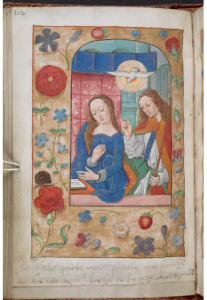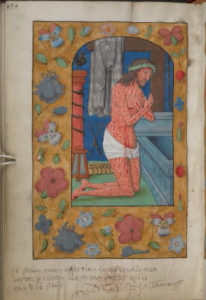Medieval Books of Hours are a uniquely intriguing type of text, largely because they are so foreign to the average reader. While they are not a part of modern culture, Books of Hours were extremely common in medieval Europe. As cultures expand, trends change—new genres and writing styles tend to replace the old. However, a single Book of Hours provides insight into the cultures and lives of individual members of society across generations in medieval Europe. Rather than being replaced by every new generation or change in trend, an already existing Book of Hours would be altered to suit the current owner and time. Changes in a manuscript provide a means of understanding its users, as well as the particular culture(s) in which it was used [1].
Many Books of Hours were created in a modular construction method. In this method, the various texts that went into a Book of Hours were produced separately [1]. The commissioner could then choose which texts he or she wanted to be included in the manuscript, based on what was available. The pre-constructed texts would be joined into a single collection. The numerous blank folios between the sections in Anne Boleyn’s Hours provide strong evidence that it was constructed in this way–scribes would typically begin every new text on a recto, resulting in blank folios. Additional miniatures and decoration could be added to these extra folios later [1]. Anne Boleyn’s Hours features wonderful instances of personal alteration, largely because its modular construction easily accommodated the addition of new folios.
The modular construction method encouraged more standardized texts–a single scribe could produce a large number of (nearly) uniform copies of a text to be used multiple manuscripts. However, a commissioner had a greater variety of texts to pick and choose from, making it easy to customize his or her Book of Hours[1]. Anne Boleyn’s Hours, for instance, did not originally belong to her. But even the original portion of her Book of Hours provides evidence of English roots.The original folios include miniatures of the very English Saint George (who becomes the patron saint of England near the time of the manuscript’s use), as well as Thomas Beckett and Etheldrea. From the start, this Book of Hours was tailored to suit English users. The modifications that took place after its initial creation provide information about how the users and era changed after the manuscript was initially created.
Changes to a Book of Hours occurred for a number of reasons. The owner may decide to invest additional money into his or her manuscript—adding decoration and/or extra quires to increase the monetary and aesthetic value of the Book of Hours. As new saints were recognized, along with prayers in their honor—an individual may want to add new texts and miniatures to a collection. Since the manuscripts were handed down over time, a new owner may wish to include texts of particular personal value.
A significant compilation of miscellaneous prayers and miniatures was added to Anne Boleyn’s Hours, beginning on folio 256v. These additions personalize the manuscript for the owner. A text of especially unique value in the added miscellany is a prayer beginning on folio 297v. The prayer is written in words that seem to be similar to those spoken by Saint Susannah in the Old Testament [2]. Very little research has been done on Susannah prayers in Books of Hours, but prayers written in this fashion seem to be very uncommon. Charity Scott-Stokes writes that Susannah represents the “true and chaste” qualities of a good wife, making her particularly important to a woman in medieval Europe. She was also considered the saint to protect against “slander, malicious gossip, and backbiting” [3]. The inclusion of this prayer provides evidence for speculating whether or not this miscellany was created specifically for a woman and, perhaps, insight into what values and vices the commissioner was most concerned with.

Arguably the most personal alterations to Anne Boleyn’s Book of Hours are the inscriptions that she and Henry VIII added to the contents–the two wrote notes of love and affection in the manuscript. At the bottom of a full miniature depicting the Annunciation, an English inscription reads: Be daly prove you shalle me fynde to be to you bothe lovynge and kynde (Be daily prove you shall find me to be to you both loving and kind). According to the British Museum, which has published a digital facsimile of the manuscript, this inscription is written in Boleyn’s hand.

Henry writes and signs the bottom of folio 231v, writing: Si silon mon affection la sufvenance sera en voz prieres ne seray gers oblie car vostre suis Henry R. a jammays (If you remember my love in your prayers as strongly as I adore you, I shall hardly be forgotten, for I am yours. Henry R. forever).
The presence of these two inscriptions provides us with the understanding that Anne Boleyn used this Book of Hours as a place to store personally meaningful texts, even if they fell outside of religious purposes. Despite Henry VIII’s brutal reputation, his inscription gives the modern reader an opportunity to see that there was also an affectionate side to his personality.
Anne Boleyn’s Hours offers modern scholars a glimpse into her world. We can see the saints and prayers that she was familiar with. As a result, we have a means of insight into which values (the ones that they represented) were important to her.
The quote that “writing is never finished, only abandoned” is attributed to the Renaissance’s Leonardo da Vinci, but I would venture to say that the idea applies particularly well to medieval Books of Hours. The opportunities for change within a Book of Hours are nearly endless–this post has barely scratched the surface.
Digital facsimile available at http://www.bl.uk/manuscripts/FullDisplay.aspx?ref=Kings_MS_9
[1] Rudy, Kathryn M. Piety in Pieces: How Medieval Readers Customized their Manuscripts. Cambridge, UK: Open Book Publishers, 2016. eBook.
PDF available at http://www.openbookpublishers.com/product/477/piety-in-pieces–how-medieval-readers-customized-their-manuscripts
[2] Vulgate Bible, The Prophecy of Daniel: Chapter 13. http://www.latinvulgate.com/lv/verse.aspx?t=0&b=32&c=13
[3] Scott-Stokes, Charity. Women’s Books of Hours in Medieval England. Cambridge, UK. D.S. Brewer, 2006. Print.